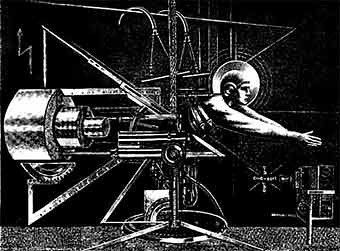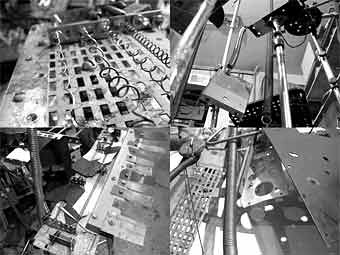Russian Industrial Music
“Honor to the Futurists who forbade the painting of female hams, the painting of portraits and guitars in the moonlight. They made a huge step forward: they abandoned meat and glorified the machine.”
– Kasimir Malevich, 1918

Image by Russian industrial musician Alexander Lebedev-Frontov.
In 1921, Russian physicist Lev Theremin, an inventor who insisted on building all his creations by hand, constructed the theremin, one of the 20 th century’s first successful electronic musical instruments and still the only music instrument whose haunting tones are elicited without touching the device. Unlike Theremin, neither famous theremin-users John Cage, Download, Brian Eno, Meat Beat Manifesto or Edgar Varese were ever arrested for its use. After a decade of teaching and performing, Theremin was suddenly seized and imprisoned in 1938 by the KGB on the grounds of “anti-Soviet Propaganda.” Theremin was sent to Siberia and later to a labor camp in Omsk, where, alongside other indentured scientists, he was forced to work on various military projects (Theremin was later given the Stalin Prize for perfecting the eavesdropping device known as “the bug”). Thus begins the history of industrial music in Russia…
Chapter One: Russian Proto-Industrial
At around the time of the theremin’s conception, diverse movements of the Russian avant-garde began to lay the groundwork for Russia’s industrial tradition. In a backlash to society’s fearful criticism of technological progress, the pre-Revolutionary movement of Russian Futurism embraced technology’s symbols, glorifying in writing and art a surrealistic gyre of pollution, noise, speed and machines. Though categorically un-industrial in their progressive outlook, the Futurists definitely anticipated early industrial methods and aesthetics with their manifesto “Slap in the Face of Public Taste,” which called for the following artists’ rights to be revered: “To feel an insurmountable hatred for the language existing before our time,” and “to enlarge the scope of the poet’s vocabulary with arbitrary and derivative words.” The work concludes with the promise that “…if for the time being the filthy stigmas of Your ‘common sense’ and ‘good taste’ are still present in our lines, these same lines for the first time already glimmer with the Summer Lightening of the New Coming Beauty of the Self-sufficient Word” (D. Burliuk, Alexander Kruchenykh, V. Mayakovsky, Victor Khlebnikov). Music of this time also experienced a dose of experimentation, and included symphonies constructed entirely of factory whistles throughout the early 1920s. The Futurist opera “Victory Over the Sun,” complete with set designs based Malevich’s “Black Square,” transformed the people on stage into “moving machines by costumes of cardboard and wire.” Meanwhile, a competing art movement called Constructivism focused on the strict practicalization of art by declaring “ Art is finished! It has no place in the human labor apparatus. Labor, technology, organization…that is the ideology of our time.” In time, these ideals would be pushed to grotesque and amusing extremes by the original industrialists.
At the beginning of the 1920s all modern art movements were officially sanctioned by the government as unsuitable for mass propaganda use. Visionaries of the Constructivist movement, in vogue at the time, were sent into exile. The government now endorsed only one type of art: Socialist Realism, a movement designed to glorify the efficacy of the Soviet Regime. Socialist Realism was famous for such gems as “Roses for Stalin,” which features beaming Russian children granting the dictator who killed an estimated 40 million of his own people a fresh bouquet. Beneath the veneer of this “artistic honesty by the demand of the masses,” there loomed a different world. In the words of Dmitry Vasilyev, editor of Russia’s Independent Electronic Music Zine,
“The Western world is well-familiar with Russian avant-garde, constructivism and futurism from the beginning of the century, but not everybody understands that while in the West art was always considered the property of the individual, that in Russia the propogandistic slogan ‘art belongs to the people’ was merely a trading coin in the political (ore precisely, ideological) games of its rulers. How else can the fact be explained that all the most important innovations in the area of synthesized sound (the technological base of industrial music) in Russia occurred in secret military research laboratories? And that nothing about them is known to this day not only in the West, but in Russia?”
Indeed, the first of these inventions, a two-voiced analog music synthesizer known as EKVODIN, was conceived in the 1930s at a Russian center called TSNIATRI, or “Automatic Devices for Defense.” Its inventor, Andrei Volodin, was not a musician at all; his task had been to conduct military research in the area of psychoacoustics. In his research, Volodin needed a source of material for his experiments with human response to various sounds, and so the EKVODIN was born. Soon the device found use at the hands of musicians, and Volodin’s synthesizer almost went into mass production but, uninterested in electronic music, the Soviet State cut funding for his project in the sixties. After that, Volodin continued working on the synthesizer, but he simply did not have the energy or resources to go on – Volodin died right in his laboratory in 1982.

Roses for Stalin, a famous example of Socialist Realism.
More success was enjoyed by the ANS – the first photoelectric synthesizer invented anywhere in the world. Designed in 1939 by Evgeney Murzin, th e technological basis of the invention lay in the synthesis of sound from an artificially drawn sound wave. Murzin was an engineer and the design of the ANS was a hobby that took 20 years to realize. Despite the fact that only one copy of the ANS was ever created, it enjoyed wide use by many Russian composers. Eerie ANS compositions by Edward Artimiev grace Tarkovsky’s sci-fi films Stalker and Solaris. In 1999, Russia’s Electroshock records released a compilation drawn from archive tapes of ANS works from 1964 – 1971. Composers on this album included Edward Artemiev, Stanislav Keitchi, and, most notably, Alfred Schnittke, whose steel-grinding-against-steel ambient-noise composition “Steam” marks the beginning of a distinctly industrial sound in Russia.
Chapter Two
“Industrial culture was about exploring the conditions of expression under ultimate control. Could meat be animated by the inanimate (metal; witness Mark Pauline)? Could the apparent limitations of machinery be pushed beyond by spirit (e.g., human ingenuity)? Could metallic-sponsored shock bring us to new insights on the human condition? New stimulations? New, previously perverse, pleasures? The answers to these questions were always implicitly affirmative. It was as if pent up creative energy. . . was allowed release, not through pure expression, but through massive control. Emblems of that kind of power which limits–metal and steel–imprisoned the artistic impulse, only to find it seeping out in screeches. As any neurotic will tell you, complete control only results in its absolute loss.”
– Joshua Gunn, Lectro-Slue: Generic Origins
If the early industrialists in the West were fetishizing the experience of expression under control, people creating a similar sound in the USSR were living it. Separated from their counterparts by the iron curtain, musicians in Russia began composing, collaging, cutting up and programming a range of sound experiments which became the first industrial projects in the USSR at a time when such activity was prohibited by the government. Bizarrely, many of these works coincided directly with the releases of groups such as Throbbing Gristle, Z’ev, NON and Cabaret Voltaire, completely unknown in Russia at the time. This suggested that the zeitgeist of industrial culture transmitted through all boundaries of communication. This section focuses on the most influential Russian industrialists who produced under the Soviet regime. They are ZGA, Nochnoi Prospekt, and Linija Mass.
One small crowded apartment gave rise to ZGA, one of Russia’s original noise projects. Searching for creative ways to perform loud music without disturbing the neighbors, Nick Soudnnick, the founding member of ZGA, began creating his own instruments, called Zgamoniums, by attaching contact microphones to metal sheets, plates of steel, iron grids, springs, and other found objects and metallic scraps. The recorded reverberations allowed him to create powerful music without performing it at a loud volume. Producing sounds by stroking contact-miked metal sheets with whips or hammering the springs with mallets, among other techniques, Soudnick was able to achieve sustained, low-frequency resonances that were picked up by the contact mikes. The microphones used by ZGA were never designed for musical purposes, but were used in Russia as a signaling devices that sent a single electrical impulse whenever, for instance, the glass to which the mikes were attached was broken [1]. Acting as an unusual pickup for instruments, several of these mikes were attached to the body of the instrument at different portions to pick up different resonances. The sound of the resulting improv noise, described by Finnish industrial musician Anton Nikkilä, functions as “a metaphor of the late Soviet or post-Soviet everyday life: rusty, broken-down, unpleasantly dominated by cold metal, functioning to seemingly impenetrable, absurd logic.” [2]

Musical instruments used by ZGA.
Jumping back to early Soviet life is another influential industrial group, Linija Mass (“Line of the Masses”). The brainchild of artist Alexander Lebedev-Frontov, Linija Mass’ releases Prolekult and The Iron Revolution (with titles such as “ Total Mobilization” and “Lenin on the Labour Discipline”) combine the sounds of military marches, revolutionary speeches, and the atrocious machinery noise. Unlike ZGA, which clearly exposed the construction behind its zgamoniums, Linija Mass remained secretive about its workings, harboring “a negative attitude towards information about our releases, because it is always a reduction.” [2] It is known that Lebedev-Frontov began creating music in the late seventies at age 19, when he began constructing sound collages by recording the machine tools at his workplace, a factory called “Red October” outside of St. Petersburg. But Lebedev-Frontov’s first industrial music experience occurred five years prior to that, when he was 13. Influenced by the Beatlemania of his friends, a young Lebedev-Frontov purchased a cheap copy of a Beatles album in St. Petersburg. The album was in a bootleg format referred to in St. Petersburg as “record on the bones,” a home-produced record etched onto X-ray film. When Lebedev-Frontov fired up the record player, he was greeted by a robust male voice confirming his desire to listen to the Beatles and delivering subsequently a string of profanities. Then, instead of the sounds of the Liverpool quartet, Lebedev-Fontov was assaulted by two minutes of membrane-tearing radiostatic crashes and terrible howls. Lebdev-Frontov describes this experience as a musical death and rebirth [3], forever steering him away from melodious compositions and propelling him towards harsh improvisational brutality.

The artwork Alexander Lebedev-Frontov of Linija Mass.
In sharp contrast to the experimental percussion of ZGA and the mobilized drones of Linija Mass stood Notchnoi Prospect (“The Street by Night”), a rhythmical, ambient-vocal band of the mid-80s. A collaboration between Alexei Borisov, Ivan Sokolov and Natasha Borzhomov, Notchnoi Prospekt began as a “techno-pop” band but soon progressed in the vein of traditional industrial a la TG [4] . Like its lineup, the musical focus of Notchnoi Prospekt constantly changed, rotating through stages of guitar-industrial, electronic dance music, a host of popular styles including bluegrass and rockabilly, noise, ambient and musique concrete. Its most significant albums, “Novoi Fisiki” (New Physicists), “Demoktratiya i Disciplina,” (Democracy & Discipline), Asbestos and “Kisolty” (Acids), reached cult status in Russia, and during the bloom of perestroika during the second half of the eighties, Notchnoi Prospekt was able to play to large crowds across Russia. The lyrics of Notchnoi Prospekt, as described by Borisov’s musical collaborator Anton Nikila, delineate mundane events in extreme detail “ while somewhere in the background looms an apocalyptic vision such as an environmental catastrophy or mindless, totalitarian masses taking onto streets,” sung of sometimes monotonously, sometimes highly melodically, sometimes in Russian, sometimes in English, and sometimes with “Danish-football-reporter-played-backwards-on-half-speed-sounding diatribes” tossed in for good measure [2]. Alexei Borisov still produces music today, moving into the realm of IDM and minimal-techno with his project F.R.U.I.T.S.
While American industrialist Z’ev was creating kinetic sculptures of metal and using them as musical instruments, Nicholas Soudnick began constructing zgamoniums in his Riga apartment in the USSR. While Throbbing and Cabaret Voltaire began their experiments in England, Linija Mass, Notchnoi Prospekt and others began creating similar sounds in Moscow and St. Petersburg. Transmission of such ideas through the iron curtain was virtually impossible – indeed, all of these musicians have all admitted in interviews that they did not become familiar with the ideas of the Western industrialists until the late 80s. As Genesis P-Orridge put it, referring to his European and American counterparts: “all of us were working before it became ‘industrial,’ and discovered each other and recognized that same kindred spirit, that same driving force, that made all of us… ‘industrial.’” However, P-Orridge remarked in the same 1983 interview that felt industrial was not strong enough to be a culture, because he didn’t think that what he and others like him did had a reverberation right around the world and back [5]. He may have been wrong. Score one for the Psychic Youth.
[1] Hopkin, Bart. “ Orbitones, Spoon Harps & Bellowphones.” Musical Recording, Accompanying Notes. 1998: Elipsis Arts.
[2] Nikkilä, Anton. “ Reviews: Russian industrial noise: Pioneers, youth league and party members.” The Wire Magazine, Nov. 01. Original, unabridged version available on Tamizdat: [http://www.tamizdat.org]
[3] Kobech, Anton. “Linija Mass.” Interview with Alexander Lebedev-Frontov. October 10, 2001. In Russian. Available at: http://www.industrialmusic.ru/docs/music/interviews/_/articles-20.htm
[4] Tolmatsky, Dmitry. “Industrial Music in Russia: A Short Review.” Part of the Industrial Culture Extended FAQ, available in Russian at http://rwcdax.here.ru/indrus.htm . This section available in English at http://rwcdax.here.ru/DIST/eng/history.htm .
[5] Vale, V., Juno, Andrea. Interview with Throbbing Gristle . Re/Search #6/7: Industrial Culture Handbook (Re/Search, 1983.)
Chapter Three: Russian Industrial of Today
I wrote the article above in two chapters (the third is not yet written) on Russian Industrial Music for Slambook, an Philly goth/industrial zine, back in 2002. The internet was a different place back then. I have a confession to make: when I first finished the article, I had not heard the music of a single musician I described. Believe, me, I’d tried to find it. But it wasn’t on the P2P networks, and MySpace didn’t exist. I remember the pain-staking research I had to go through to get every scrap of information: every picture, every quote. Now, everything is different. All it took was hitting the “I’m Feeling Lucky” button on Google each time and within 20 minutes, I found every photo that had taken me weeks to locate when I first wrote this article, and more music than I could ever imagine. It’s amazing to me how immediate and accessible information has become. Do not take this for granted. Search out for new music and knowledge every day. Enjoy this era of the Internet while it lasts. Here are the precious links I was missing when I wrote this 5 years ago:
Linija Mass MySpace
Notchnoi Prospekt MySpace
ZGA Website
Maybe it’s the right time to finally write the third installment of this article, which deals with Russian Industrial of the present day. Stay tuned..

October 10th, 2007 at 7:32 pm
Beach Boys used the Theremin on “Good Vibrations”
October 10th, 2007 at 11:39 pm
Great article..! Kudos.
Russian industrial culture has a wholly different aesthetic than the Western kind. This was a real eye-opener, thanks.
October 12th, 2007 at 3:16 am
Louis… the Beach Boys actually used a tannerin for the Pet Sounds sessions, not a theremin. The tannerin was invented by Tom Polk, and while it’s based off similar designs, it is played verrrrry very differently. :)